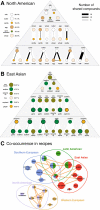Flavor network and the principles of food pairing
- PMID: 22355711
- PMCID: PMC3240947
- DOI: 10.1038/srep00196
Flavor network and the principles of food pairing
Abstract
The cultural diversity of culinary practice, as illustrated by the variety of regional cuisines, raises the question of whether there are any general patterns that determine the ingredient combinations used in food today or principles that transcend individual tastes and recipes. We introduce a flavor network that captures the flavor compounds shared by culinary ingredients. Western cuisines show a tendency to use ingredient pairs that share many flavor compounds, supporting the so-called food pairing hypothesis. By contrast, East Asian cuisines tend to avoid compound sharing ingredients. Given the increasing availability of information on food preparation, our data-driven investigation opens new avenues towards a systematic understanding of culinary practice.
Figures



 . North American and East Asian cuisine shows the opposite trends. (K,L) If we remove the highly contributing ingredients sequentially (from the largest contribution in North American cuisine and from the smallest contribution in East Asian cuisine), the shared compounds effect quickly vanishes when we removed five (East Asian) to fifteen (North American) ingredients.
. North American and East Asian cuisine shows the opposite trends. (K,L) If we remove the highly contributing ingredients sequentially (from the largest contribution in North American cuisine and from the smallest contribution in East Asian cuisine), the shared compounds effect quickly vanishes when we removed five (East Asian) to fifteen (North American) ingredients.
 ), ingredient pairs (largest
), ingredient pairs (largest  ), and ingredient triplets (largest
), and ingredient triplets (largest  ). The size of the nodes reflects the abundance
). The size of the nodes reflects the abundance  of the ingredient in the recipes of the particular cuisine. Each color represents the category of the ingredient (see Fig. 2 for the color) and link thickness indicates the number of shared compounds. (C) The six most authentic ingredients and ingredient pairs used in specific regional cuisine. Node color represents cuisine and the link weight reflects the relative prevalence
of the ingredient in the recipes of the particular cuisine. Each color represents the category of the ingredient (see Fig. 2 for the color) and link thickness indicates the number of shared compounds. (C) The six most authentic ingredients and ingredient pairs used in specific regional cuisine. Node color represents cuisine and the link weight reflects the relative prevalence  of the ingredient pair.
of the ingredient pair.References
-
- Rozin P. The selection of foods by rats, humans, and other animals. Advances in the Study of Behavior 7, 21–76 (1976).
-
- Pfaffman C. Olfaction and taste V, chap. Phylogenetic origins of sweet sensitivity (Academic Press, New York, 1975).
-
- Garcia J. & Hankins W. G. Olfaction and taste V, chap. The evolution of bitter and the acquisition of toxiphobia (Academic Press, New York, 1975).
-
- Drewnowski A. & Greenwood M. R. C. Cream and sugar: human preferences for highfat foods. Physiology & Behavior 30, 629–633 (1983). - PubMed
-
- Diamond J. M. Guns, germs, and steel: The fates of human societies (W.W. Norton, New York, 1997).
Publication types
MeSH terms
Substances
LinkOut - more resources
Full Text Sources
Other Literature Sources

